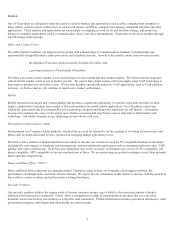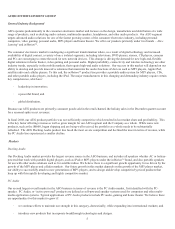Plantronics 2008 Annual Report Download - page 18
Download and view the complete annual report
Please find page 18 of the 2008 Plantronics annual report below. You can navigate through the pages in the report by either clicking on the pages listed below, or by using the keyword search tool below to find specific information within the annual report.12
held management positions in the distribution and marketing divisions of Bang and Olufsen Group, a global manufacturer of
consumer electronics. He holds a degree in Business Administration and Management from the Copenhagen Business School in
Denmark.
Mr. Vanhoutte joined Plantronics in September 2003 as Managing Director of EMEA. From October 2001 until September 2003 he
served as Corporate Vice President of Marketing at Sony Ericsson Mobile Communications. From October 2000 to October 2001,
Mr. Vanhoutte served as Vice President of Strategic Market Development at Ericsson’s Personal Communications Division. From
December 1998 until September 2000, he served as Senior Vice President of Products, Marketing and Sales at MCI WorldCom’s
International Division in London. From November 1994 until December 1998 Mr. Vanhoutte held various marketing and general
management positions at Dell Computer Corporation including, General Manager for the Business Systems Division in the United
States, Managing Director for Dell Direct in the United Kingdom and Ireland and Vice President of Products, Marketing & Services
for EMEA. Beginning in June 1991 he worked for Nokia Data as Vice President of Marketing, which was merged into Fujitsu-ICL
Systems Inc. where he continued as Vice President of Marketing, Personal Systems and Client-Server Division until November 1994.
From 1985 until May 1991 Mr. Vanhoutte worked in various European marketing and division manager roles with Wang
Laboratories. He started his career at Arthur Andersen’s Benelux Information Consulting Division in 1977 where he specialized in
structured programming and office automation. Mr. Vanhoutte studied Applied Economics and Engineering at the University of
Leuven, Belgium.
Mr. Yort joined Plantronics in June 2005 as Vice President and General Manager of B2B Solutions. Prior to joining Plantronics, Mr.
Yort was Vice President of Business Development at Venturi Wireless, where he led strategic relations with mobile wireless carriers
and infrastructure players. Before Venturi, he was the Vice President of Business Development and Marketing at PolyFuel, Inc., a
pioneer in direct methanol fuel cell-powered products. From 1998 to 2000, Mr. Yort directed Palm, Inc.’s enterprise business as its
general manager. He has also held management positions at 3Com, HP and Inmac. Mr. Yort has a Master of Business Administration
from Stanford University's Graduate School of Business,and Bachelor of Science in Engineering, and Bachelor of Arts degrees from
Princeton University.
Executive officers serve at the discretion of the Board of Directors. There are no family relationships between any of the directors and
executive officers of Plantronics.
ITEM 1A. RISK FACTORS
Investors in our stock should carefully consider the following risk factors in connection with any investment in our stock. Our stock
price will reflect the performance of our business relative to, among other things, our competition, expectations of securities analysts
or investors, and general economic market conditions and industry conditions. Our business, financial condition and results of
operations could be materially adversely affected if any of the following risks occur. Accordingly, the trading price of our stock could
decline, and investors could lose all or part of their investment.
Our operating results are difficult to predict and fluctuations may cause volatility in the trading price of our common stock.
Given the nature of the markets in which we compete, our revenues and profitability are difficult to predict for many reasons,
including the following:
xour operating results are highly dependent on the volume and timing of orders received during the quarter, which are
difficult to forecast. Customers generally order on an as-needed basis, and we typically do not obtain firm, long-term
purchase commitments from our customers. As a result, our revenues in any quarter depend primarily on orders booked
and shipped in that quarter;
xwe incur a large portion of our costs in advance of sales orders because we must plan research and production, order
components and enter into development, sales and marketing, and other operating commitments prior to obtaining firm
commitments from our customers. In the event we acquire too much inventory for certain products, the risk of future
inventory write-downs increases. In the event we have inadequate inventory to meet the demand for particular products,
we may miss significant revenue opportunities or incur significant expenses such as air freight, expediting shipments,
and other negative variances in our manufacturing processes as we attempt to make up for the shortfall. When a
significant portion of our revenue is derived from new products, forecasting the appropriate volumes of production is
even more difficult;
xin the ACG segment, our prices and gross margins are generally lower for sales to Business-to-Consumer (“B2C”)
customers compared to sales to our Business-to-Business (“B2B”) customers. In addition, our prices and gross margins
can vary significantly by product line as well as within product lines. Therefore, our profitability depends, in part, on the
























